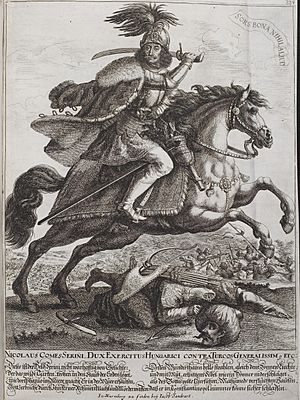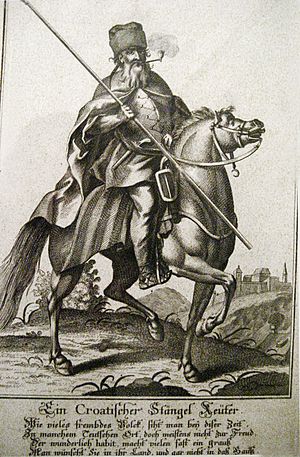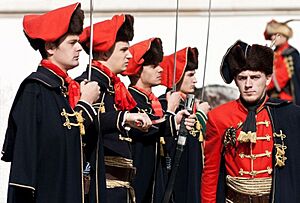Croats (military unit) facts for kids
Quick facts for kids Croats |
|
|---|---|
| Active | 17th century |
| Country | Habsburg monarchy |
| Allegiance | |
| Branch | light cavalry |
| Type | auxiliary |
| Role | off-battlefield |
| Equipment | Carbine and pistols |
| Engagements | |
| Commanders | |
| Initial structures | Count of Tilly |
| First regular regiments | Albrecht von Wallenstein |

The Croats, also known as Cravats or Crabats, were a type of light cavalry (soldiers on horseback) in Central Europe during the 1600s. They were similar to hussars, another type of light cavalry.
At first, the Croats were not part of a regular army. They were organized in small, loose groups. However, the first official Croat regiment (a military unit) was formed in 1625.
The Croats are most famous for fighting with the Catholic League during the Thirty Years' War. This was a major war in Europe from 1618 to 1648. At one point, about 20,000 Croatian cavalry served in the Imperial Army.
The name "Croats" became a general term for light cavalry from the Habsburg monarchy's border areas. It didn't just mean people from Croatia. These units included people from different backgrounds like Croats, Hungarians, Serbs, Wallachians, Poles, Cossacks, Albanians, and Tatars.
Contents
How the Croats Started
The Croats were first recruited by generals working for the Habsburg monarchy. Soldiers would join for a specific military mission. They often hoped to find valuable items (booty) or earn a fee.
In the beginning, these groups were not very organized. After a mission, they would often go home. Then, in the spring, their old commanders would recruit them again.
In 1623, the number of Croat units under Count of Tilly was reduced. They still fought in the 1623 Battle of Stadtlohn under Tilly's command.
Denmark also hired Croat troops during the Swedish Wars (1657-1660) and the Scanian War (1676-79). During the Scanian War, they were led by Disznoldt. They were stationed in the strong town of Landskrona in Scania. They often went on "small war" missions with local soldiers.
Becoming Regular Units
The first official Croat regiment was created in 1625. This was done by Hector Ludwig Isolani, a military officer who worked for Albrecht von Wallenstein.
These cavalry units were used to confuse the enemy by attacking their sides. They were known for their tough fighting methods. For example, during the Sack of Magdeburg, the Croats were involved in the fighting. By late 1633, some Croats also began to serve in the army of the Kingdom of France.
What They Wore and Used
The Croats wore hats made of fur and long red cloaks. Their main weapon was a carbine, which is a type of rifle. They also carried two pistols.
An interesting part of their uniform was the scarf they wore around their necks. This was probably for cleanliness. During the Thirty Years' War, French soldiers saw the Croats' scarves. They liked them and started wearing similar ones, calling them cravate (French for cravat). This word later led to the modern-day cravat and necktie.
Today, the Cravat Regiment is an honor guard formed in 2010 in Zagreb, Croatia. They wear uniforms that are exact copies of what the original Croats wore.
Their Lasting Impact
The Croat military units had a big impact. Between 1631 and 1638, similar cavalry units were formed in Bavaria, Spain, and France.
Even in the early 1900s, mothers would tell stories about the 1631 Sack of Magdeburg to scare their children. People in eastern France would compare any invasions after the Thirty Years' War to the stories of the Croats and Swedes who caused damage in their area in the 1630s.
The Croats are also mentioned in famous books and plays. They appear in Simplicissimus by Grimmelshausen and in Wallenstein by Friedrich Schiller.
Images for kids
-
Nikola Zrinski fighting against the Ottomans.






